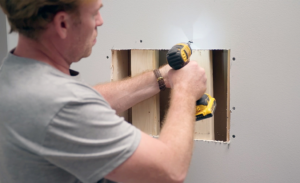Electricians are the unsung heroes who ensure homes, businesses, and industrial facilities have electricity. Their job is physically demanding and requires adherence to strict safety protocols.

The best way to become an electrician is by enrolling in a trade school and taking electrical courses. These programs typically last four years and include on-the-job training and classroom instruction. To learn more, visit https://www.p2electricalcontracting.com/nashville-electrician.
A well-written electrician job description can attract candidates and help you speed up the hiring process. It can also demonstrate your company’s commitment to quality and integrity. However, it’s important to keep in mind that your job posting needs to be concise and clear. It should not contain more than 300 words and must include a brief summary of your employer’s requirements.
Electrical engineers work indoors and outdoors at homes, businesses, and factories. They can perform routine maintenance or repair complex electronic equipment, such as motors, transformers, generators, and industrial machinery. They may also advise management as to whether continued operation of certain equipment could be hazardous. They typically collaborate with other skilled tradespeople, such as engineering technicians, line installers and repairers, or industrial machinery mechanics and maintenance workers.
Electricians work with clients, architects, and construction professionals to design and install indoor and outdoor electrical control, wiring, and lighting systems. They are also responsible for establishing backup power sources, upgrading outdated systems, and meeting regulatory standards. They may also provide advice on energy efficiency and alternative power generation.
In this career, you will need to be able to handle physically demanding tasks such as drilling holes, digging trenches, and moving or lifting heavy objects. You will also need to be comfortable working in cramped spaces and at heights, as well as in hot or cold weather conditions. Additionally, you must be able to follow instructions and work under the supervision of a journeyman electrician or master electrician.
The career of an electrician is both rewarding and challenging. There are many opportunities for advancement and lifelong learning, as well as a variety of specializations to choose from. Many vocational schools and community colleges offer courses in electricity to train students for careers as electricians. Experienced electricians can also choose to become instructors and mentors to the next generation of technicians. Others choose to be electrical inspectors, ensuring that new installations comply with safety codes and regulations.
The salary of an electrician varies depending on the area in which they specialize and the amount of experience they have. In general, a journeyman electrician can expect to earn between $60,000 and $100,000 per year. In addition, many electricians choose to pursue freelance opportunities or own their own electrical business. These jobs can be lucrative and provide a flexible schedule.
Education and training requirements
A career as an electrician requires a combination of education and hands-on experience. There are a variety of educational pathways to becoming an electrician, from a certificate program at a trade school to a four-year bachelor’s degree. However, all of these programs prepare students for the rigors of the job. This field demands strong attention to detail and a commitment to lifelong learning. It is also a highly regulated profession, with strict adherence to standards and safety protocols.
The most common way to become an electrician is through a formal apprenticeship. These programs typically last 4-5 years and involve both classroom instruction and on-the-job training. The program offers a comprehensive overview of electrical theory and systems design, including circuitry, wiring, and equipment installation and maintenance. It also provides a thorough grounding in physics, mathematics, and engineering.
An associate degree in electrical technology is another popular option. This two-year program is offered by many colleges and can provide a stepping-stone to a bachelor’s degree. These programs offer a broad overview of the field, and some offer specialization in areas like renewable energy or industrial electrical technology.
Regardless of the route you choose, you must obtain an electrical journeyman’s license to work as an electrician. This process takes a minimum of 720 hours of coursework and on-the-job training. It is recommended that you enroll in a vocational school with accreditation from the Division of Industrial Relations of your state. This will ensure that you receive the most up-to-date training in the industry.
Other important requirements include the ability to read blueprints and a high level of mechanical knowledge. You should also have good color vision to distinguish the various wires in a system. Moreover, you must be comfortable working in cramped spaces for prolonged periods of time. You must also be able to lift heavy loads.
Some Electricians choose to complement their technical education with a minor in business administration. This minor helps them develop the skills necessary to manage projects and budgets effectively. Additionally, it enables them to gain insights into the operations of industrial manufacturing plants. It also equips them with a deeper understanding of industrial electrical systems and automation, which are crucial for industrial settings.
Work environment
Electricians are often on the go and may have to travel for their work. This can be difficult for those who live far from their workplace, especially if the job site has inclement weather conditions like rain or high winds. In addition, electricians can spend long periods of time in cramped spaces and may be required to stand or kneel for extended periods.
Most electricians work full-time. They may have to work during the night or on weekends to address emergency repairs and meet construction deadlines. This can affect their personal life, especially if they have family or other obligations. However, electricians can maintain a healthy work-life balance by setting boundaries with their coworkers and balancing physical and mental self-care.
In addition to completing routine installation and maintenance tasks, electricians also collaborate with other project members to ensure electrical systems are integrated into the larger scope of a construction or remodeling project. This includes working with HVAC and plumbing professionals to avoid system conflicts, liaising with architects to understand structural layouts, and communicating with safety inspectors to adhere to regulations.
While the physical demands of this career can be stressful, it can be a rewarding occupation for those who enjoy problem-solving and building. Many electricians find that the satisfaction they receive from their work helps them achieve a healthy work-life balance. In addition, it is important for electricians to prioritize their personal health by exercising regularly and getting enough rest.
In addition, electricians should consider exploring flexible scheduling options to better align their professional and personal lives. This will allow them to take advantage of opportunities for advancement, while ensuring that professional development does not encroach on their personal life.
Those in the field of electricity should also look into joining a network of peers who can offer support and advice. These networks can help them navigate the unique challenges of their careers and provide a sense of camaraderie with others in their profession. They can also be a source of inspiration for new innovations that improve their work experience and reduce the risks associated with their jobs.
Salary
The salary of an electrician can vary widely, depending on the type of work they do and where they live. Some states have higher average salaries, while others have lower ones. These differences are due to a variety of factors, including state and industry-specific demand for electricians.
The number of job openings for electricians also affects their salaries. Some states have more openings than others, and the number of available positions can change as new construction projects start or existing ones are completed. For example, if a power plant or other project requires more electricity than normal, it will increase the need for electricians. This can also increase the salary of experienced electricians.
Another factor that can affect the salary of an electrician is specialization. Licensed electricians who focus their career development efforts in high-demand areas, like industrial automation or renewable energy, can earn more money than those with more general skills. This is because the more specialized an electrician is, the more valuable their expertise is to employers.
Experienced electricians boast a nuanced understanding of intricate electrical systems and have a proven track record of troubleshooting. They also know how to tackle a diverse range of problems, which is why they are often paid a premium for their services. Additionally, obtaining additional certifications can significantly boost an electrician’s earning potential. These credentials are akin to electrical badges of honor and showcase an electrician’s proficiency in the latest technologies, which employers are willing to pay a premium for.
Besides being certified, electricians can make more money by starting their own companies. Although this is a risky and expensive venture, it can yield great returns in the long run. Moreover, it can help them secure the best possible employment opportunities and build loyalty among clients.
Some states have a larger pool of qualified electricians, and as such, offer higher wages. For example, a residential electrician can make more money in Silicon Valley than in other parts of the country, because of the city’s unique technology and energy demands. However, other factors like the cost of living and competition for skilled tradespeople can also influence the salary of an electrician.

